Planaria in the aquarium
As soon as a photo of an elongated, worm-like creature on the aquarium glass appears on Facebook or in a forum, you don't have to wait long at all for the first person to diagnose a planarian. In this blog post, we would like to take a look at these unloved flatworms and provide a bit of clarification.
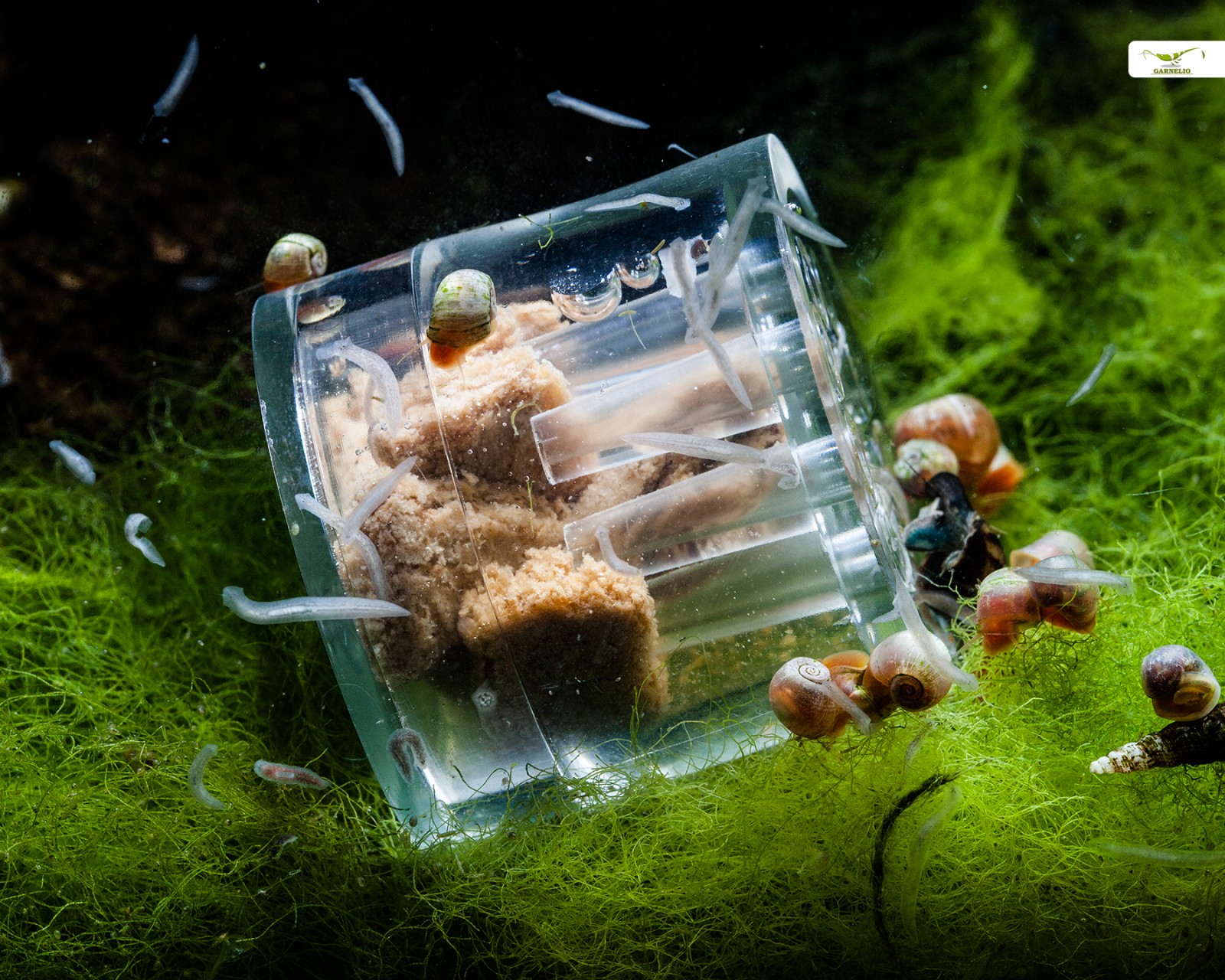
Planarians are especially in aquariums with dwarf shrimp and aquarium snails feared predators. They can also attack live shrimp. Often the use of Panacur or Flubenol is recommended if you want to eradicate them completely. However, if you have caught a less aggressive strain, it may be enough to contain the population of planarians with the help of this thoughtfully designed trap. About the product: Planaria trap with 8 holes - €7.99
Real Planaria
First of all, we need to clarify a confusion of terms: There are two kinds of planarians in our colloquial language: on the one hand, "planarian" is even used on Wikipedia as a synonym for all whirligig worms, but then there are the "real" freshwater planarians, the so-called Paludicola. These "real" planarians are the ones you don't want in your aquarium. The other whirl worms are just as predatory as the planarians, but they are harmless to our shrimp and even to most snails because they eat mostly other worms and tiny animals from the microfauna.
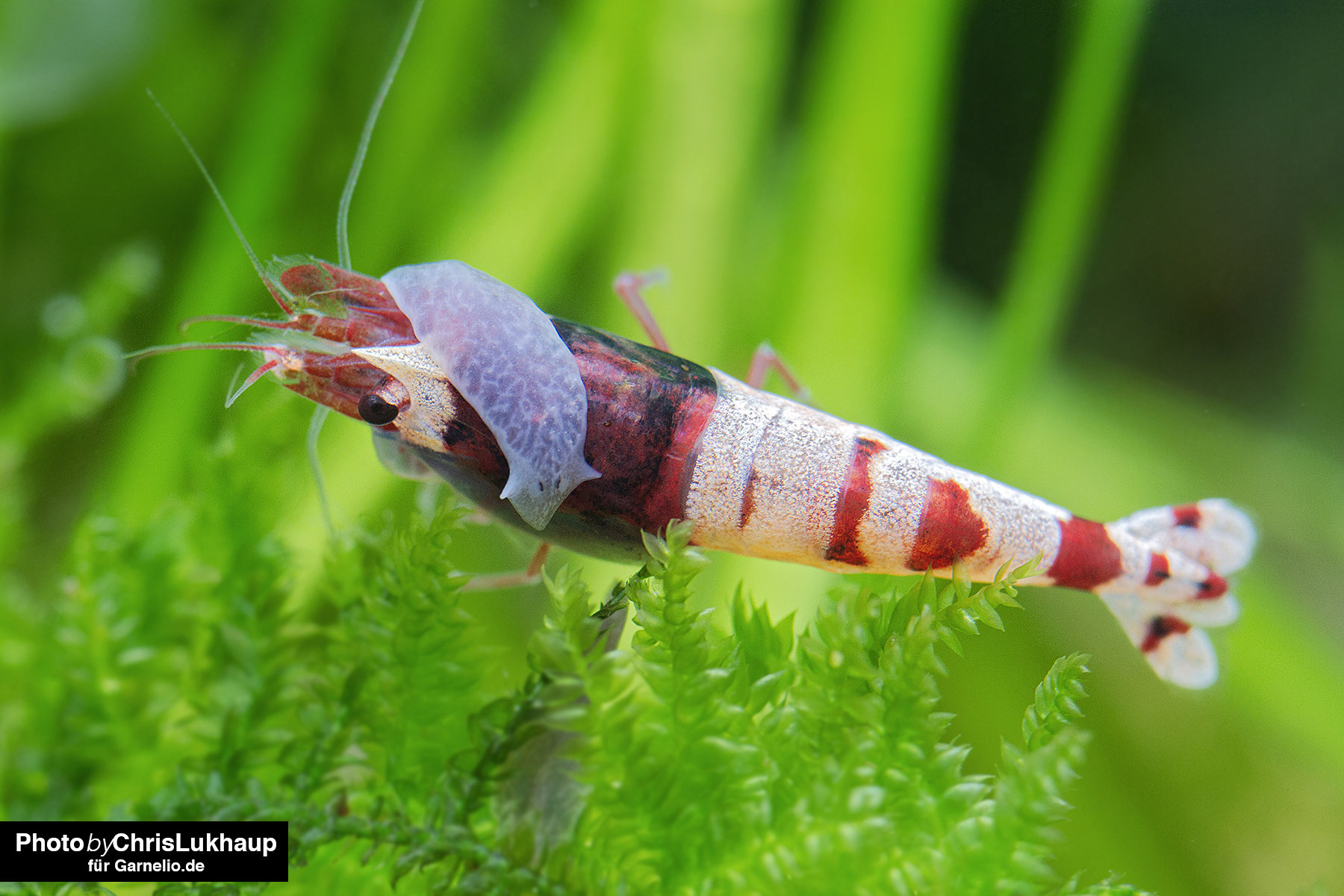
The characteristics of a real planarian
But how can you recognize a real planarian? Fortunately, these worms have some very distinct characteristics that only they possess and by which you can clearly determine what you are really dealing with.
Sure: a planarian is a flatworm and therefore has a very flat, relatively wide body cross-section. But there are many other worms that do not have a round body and are still not true planarians.
Quite often it is claimed that you can always (!) recognize real planarians by their triangular head. On the one hand, however, many people think that "pointed at the front" can also be considered as triangular - which is definitely not the case! There are many harmless worms that are not roundish in the front, but have a distinct tip, but they are not planarians. The famous triangular head of planarians is shaped like an arrowhead, so it really does have three distinct corners, and it's clearly set off. 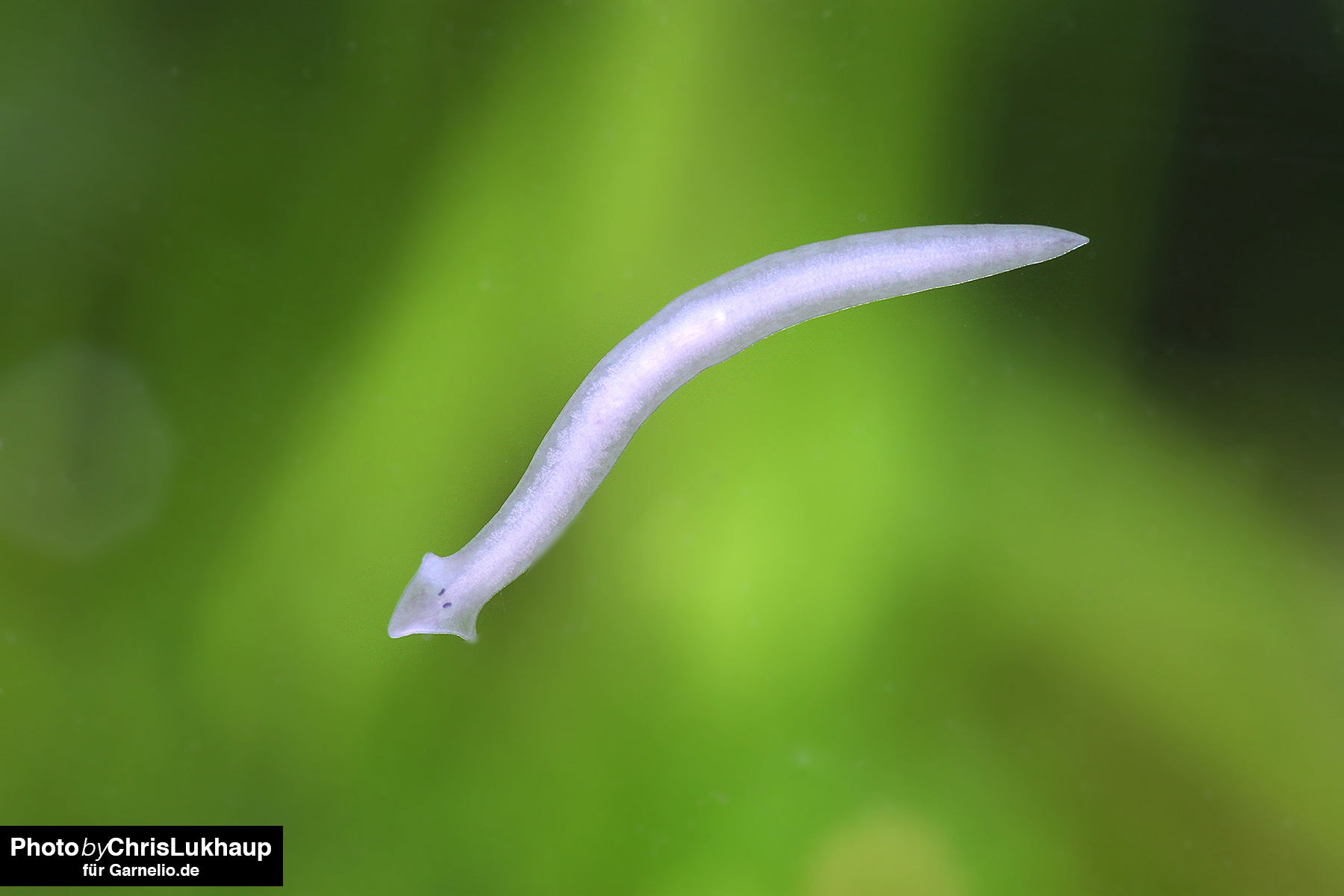
This is the good news: if the worm has a clearly separated triangular head that looks like the tip of an arrow, it is a true planarian. The bad news is that there are also some true planarians that do not have a triangular head. There are species that are more rounded in the front, that have a triangular head but with very rounded tips, some are square in front or have a sort of "cat's ears". Thus, this characteristic is not necessarily useful as the sole diagnostic marker.
However, all planarians have a three-legged intestine and a clearly visible bright maw spot approximately in the middle of the body. From this maw (the planarian does not have its mouth at the front of the head, but directly in the middle of the "belly") one intestinal part extends forward towards the head, and two intestinal parts reach to the back. In addition this intestine is still very strongly branched. If the planarian has eaten something strongly colored (for example a posthorn snail ...), you can see this intestine really well.
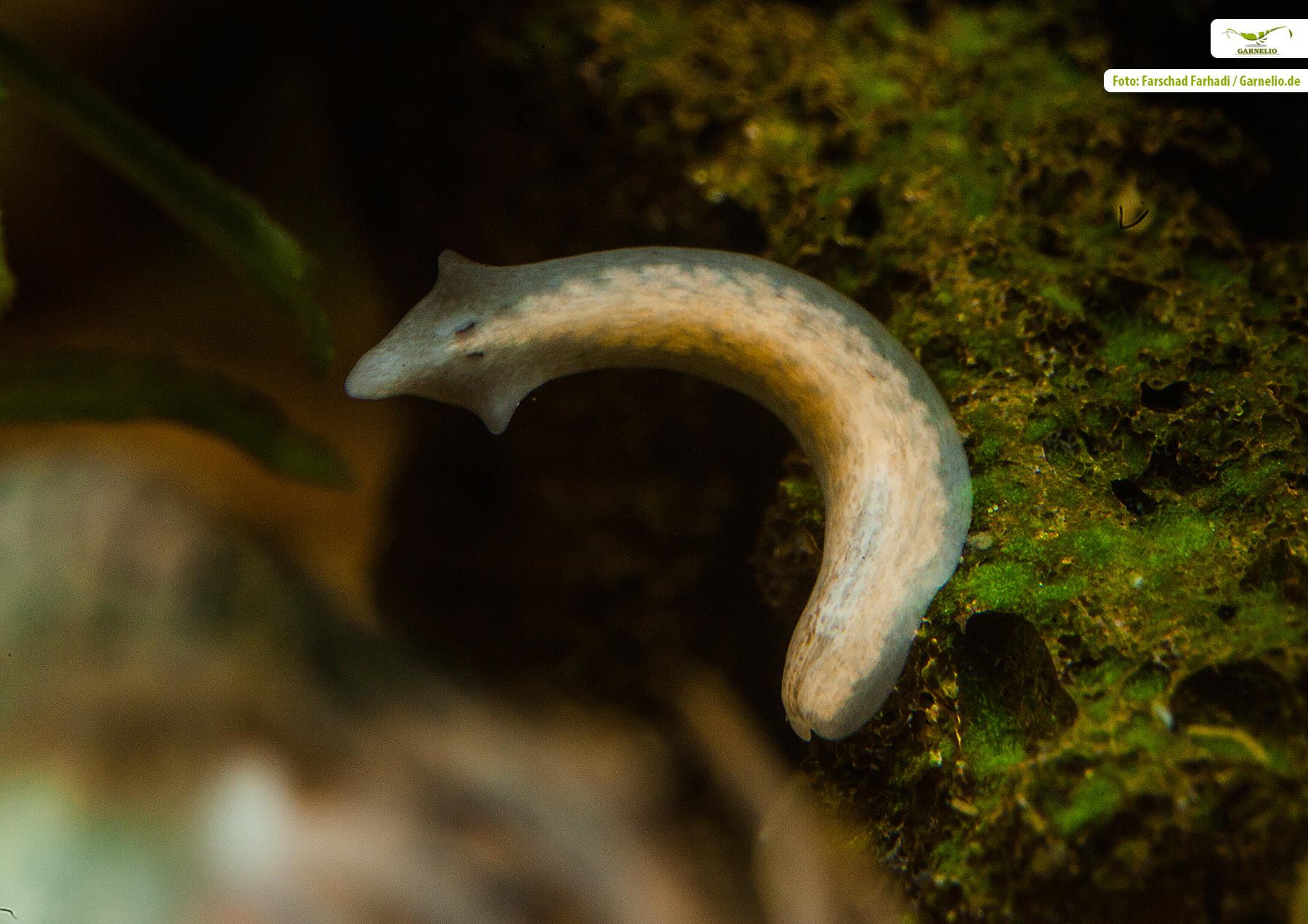
Furthermore all planarians have two well visible eye spots on the right and left side of the head, which can be seen with the naked eye. With these eye spots the planarian can even distinguish light and dark.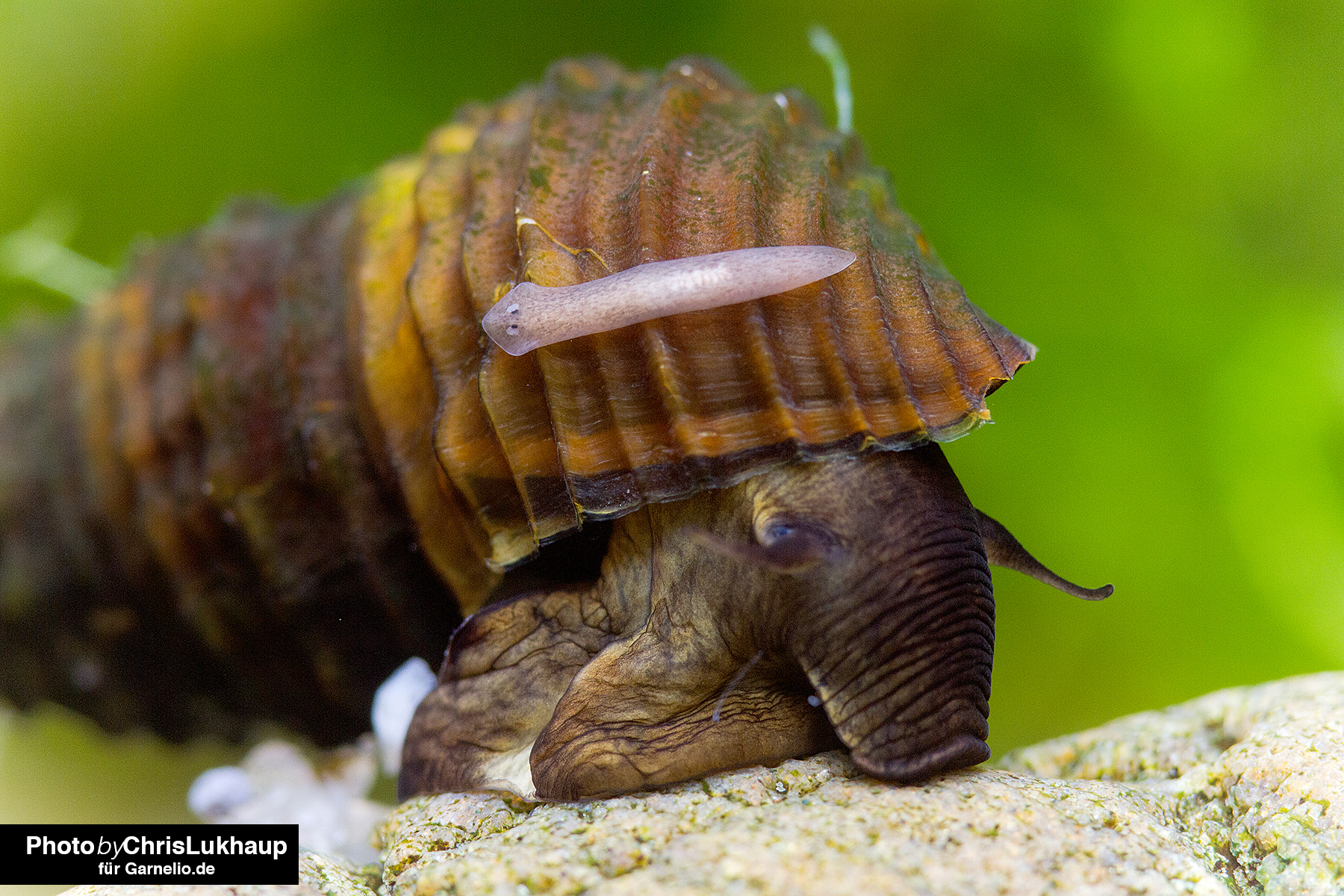
So: take a good look, even if the head is not triangular ..
The reproduction of planarians
Planarians can not only reproduce asexually by division, they also lay egg cocoons as permanent eggs. These dark brown permanent eggs sit on a small stalk. are characterized by an exceptionally thick, robust egg case. They are insensitive to heat, drought and frost and also to many chemicals.
Where do planaria actually come from in the aquarium?
Planarians are often introduced by permanent eggs, which can be attached to plants, stones, roots or other decorative objects from infested tanks. You can also collect the eggs with frozen food, and very often planarians sit in the shell tissue of snails and thus come into the aquarium as stowaways. Of course you can also collect them with fish or shrimps.
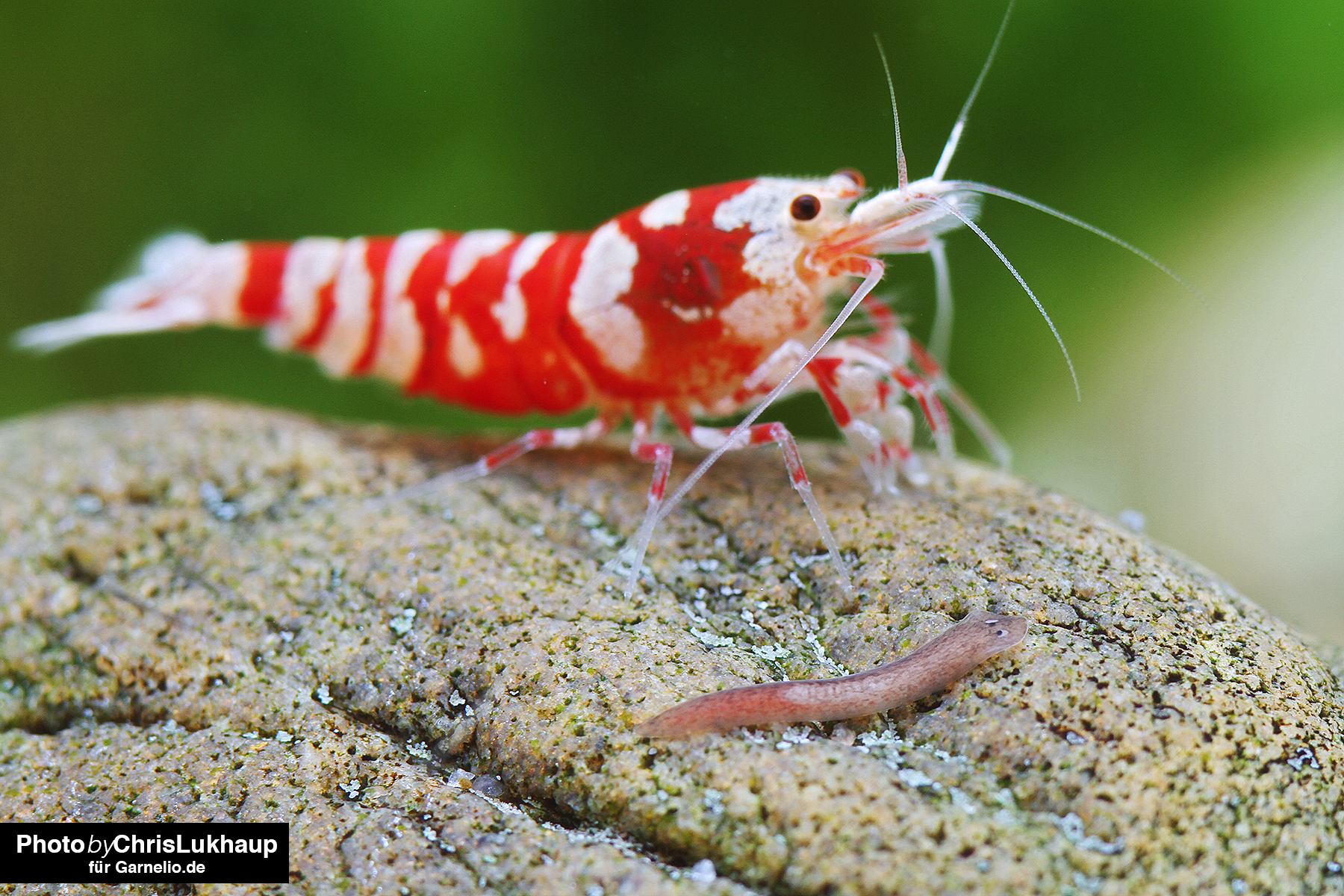
Planaria as predators
Why exactly do we not want planarians in the shrimp aquarium? First of all, let's keep in mind that not all planarians are nasty, all devouring and killing shrimp killers. However, there are indeed predatory strains, and in a shortage situation they also attack shrimp (preferably weakened animals and freshly skinned ones, which are still soft and therefore easy prey), but planarians are rarely to blame for mass shrimp deaths.
Many planarians because of much food
The other way around is more likely: A lot of food means a strong reproduction. If the shrimp die from something else, for example from an unrecognized bacterial infection, the planarians will find plenty of food: dead and dying shrimp. Although planarians live predatorily, they also like to eat carrion - after all, it doesn't run away, and eating carrion thus costs less energy than hunting live, fit prey. If the shrimps die now, the planarians find a lot of food and multiply strongly according to the food supply. Now the aquarist sees many planarians in his tank and promptly draws the wrong conclusion: I have planaria, that's why my shrimps are dying - but the death of the shrimps is actually the cause and not the effect of the planaria infestation!
Planaria sighted - what to do?
Nevertheless, we have now discovered and safely identified a planarian in the aquarium. Since we can safely assume that for every planarian we see, there are at least ten in the substrate, in the plants and also in the filter, we should do something - but what?

Unsuitable measures
A very bad idea is squashing. Planarians are favorite children of stem cell research, and their ability to regenerate is legendary. They contain so many stem cells that they can completely reconstitute themselves from a tiny piece. So instead of one planarian, you have dozens after crushing!
Starvation does not work with planarians either. On the one hand they can feed on the microfauna in the aquarium for a long time, on the other hand they are even able to digest themselves and thus stay alive for a very long time. An attempt by an aquarist to starve out planarians in a beaker of water with no other additions was abandoned after half a year without results.
Ineffective measures
Collecting is one possibility, but due to the light shyness of the planarians it is not really effective. You simply never see them all ... the same applies to fogging the visible planarians with lemon juice, pomegranate extract, Easy Carbo or boiling hot water. Helps great against the ones you can see, doesn't help at all against the ones you can't see. It is claimed that planarians also die from high energy light like blue laser light - but here we have the same problem - it only helps against the ones that are sitting at the front screen and that you hit with it. All this may work, but these methods are not effective against a heavy infestation.
Effective measures
A planarian trap takes advantage of the planarians' greed for proteins. When loaded with a piece of raw chicken or other raw, unseasoned meat, or with some frozen food, the trap is almost irresistible and attracts the pests in high numbers. Thanks to the design of the trap, the worms get in but do not get out. Thus, the number of planarians in the aquarium can be significantly reduced. In many cases, this measure is already sufficient to keep the population small. In the case of relatively peaceful planarian strains, no further control is necessary.
Basically, planarians are highly sensitive to acids, and a pH value of less than 4 is deadly for them. So in an aquarium without stocking you can simply lower the pH accordingly and you are rid of the plague - for the time being. Since, as mentioned above, they can lay permanent eggs that are unaffected by acidity, heat, frost and drought, this treatment only helps against the already hatched worms, not the eggs. Since the eggs take about ten days to hatch at room temperature, you should treat them again after about two weeks to catch the newly hatched worms. After two weeks they have already hatched, but are not yet sexually mature, so they have not already laid egg cocoons.
CO2 in high doses (for example in strongly bubbling mineral water) also kills planaria reliably, but the same applies here: After two weeks, treat again.
Often recommended is Panacur or Flubenol - both worming agents from veterinary medicine and only available against prescription in the pharmacy or directly from the veterinarian. Both agents are not approved for use in aquariums and therefore there are no official dosage instructions. Note: Flubenol kills all snails in the aquarium, Panacur kills almost all. Only post horn snails, bubble snails and the common Malayan turret snails are spared, all others (apple snails, Tylomelania, Brotia, piano snails, swamp cover snails and so on) die from it. Since Panacur does not dissolve in the water, the active ingredient particles settle in the substrate and can kill the snails even after months, which one would like to put into the then again planaria-free aquarium.
Since Panacur as well as Flubenol are available in different formulations (as paste, tablet or liquid) and in different concentrations, we cannot give exact dosage instructions here. A bit of calculation is required here: for Flubenol you need 0.1-0.2 mg of flubendazole (i.e. the pure active ingredient) and for Panacur 0.25-0.5 mg of fenbendazole per 1 liter of aquarium water. Please never underdose or treat only once, both would lead to resistance!
The active substances inhibit digestive enzymes in planarians and lead to death after a few days. After one week a really big water change (80% or more) should be done and the substrate should be vacuumed very thoroughly. Then after 14 days re-treat again with the same dose.
Important: Whether to decimate the planarian population, to simply keep them under control or before treating them with worming agents - the use of a planarian trap is recommended in any case! It simply makes sense to decimate the number of planarians before killing them, because that way the number of dead worms in the aquarium is much smaller and water quality problems are less likely to occur.
Predators
Planarians don't taste - they are surrounded by a bitter mucus coating and can even fire small pointed "arrows" called rhabdites when threatened. Nevertheless, there are animals that like to eat planarians. These include Macrobrachium peguense, the red scissor shrimp, also called Macrobrachium inlesee. Threadfish and some gobies are also said to eat planarians. However, these aquarium inhabitants can also go after shrimp and are therefore not necessarily the first choice for planarian control in shrimp aquariums.
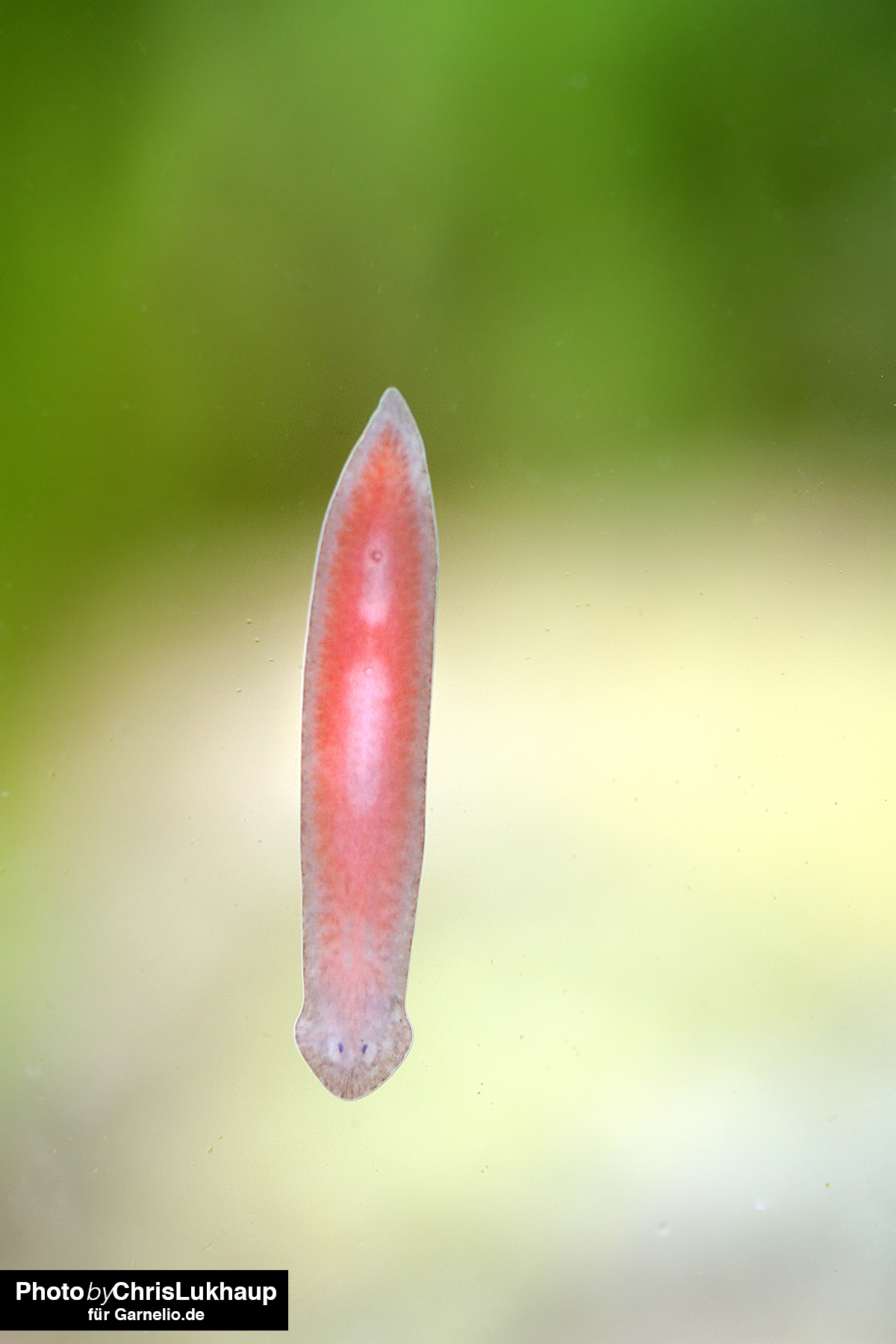

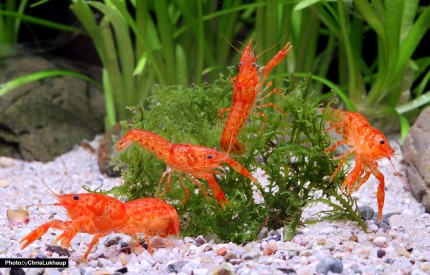
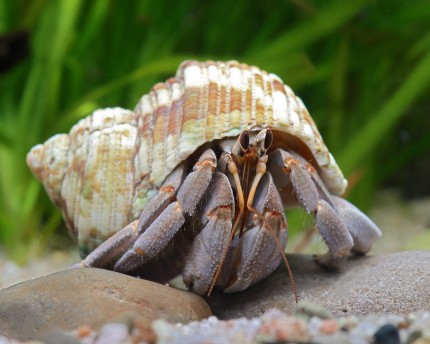
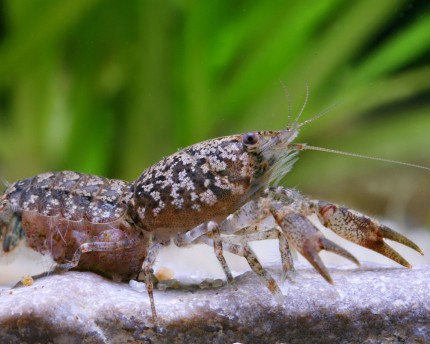
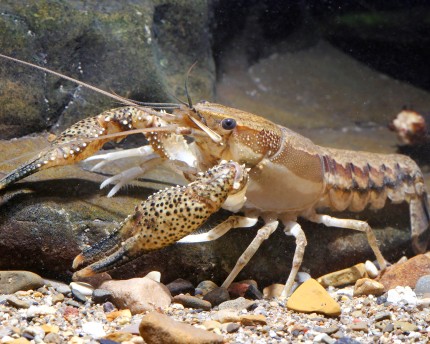
Genial
Toller Beitrag! Endlich mal alles Wissenswertes zu Planatien in einem Text! Toll gemacht :)
Klasse
Vielen Dank,
sehr schöner und hilfreicher beitrag,tolle arbeit!!!
Super
Danke für die tolle Aufklärung
Soweit sehr hilfreich aber:
Wenn ich alle Aquarienbewohner, außer der Planarien aus dem Becken entfernt habe und den bodegrund wechsel, sollte ich dann vor dem neu einrichten des Becken trotzdem behandeln? Und wenn ja, womit am effektivsten?
Antwort zu Sarah
Hallo Sarah,
am besten behandelst du das Aquarium dann einfach so, wie es im Text steht. Es gibt verschiedene Methoden, die alle ganz gut funktionieren, aber das ist da ja gut erklärt. Wichtig: Nach zwei Wochen nachbehandeln, weil erst dann eventuell vorhandene Eier geschlüpft sind.
Sehr aufschlussreich und gut erklärt.
Werde es mal mit meiner CO2 Anlage ausprobieren. Bin echt gespannt, ob es funktioniert. Zum Glück habe ich momentan keine Minnigarnelen entdeckt.
sehr informativ!
Bin als Laie hier herein gestolpert und fand den Artikel über den lästigen Wurm und seine Fähigkeiten sehr spannend. Stellt sich die Frage, ob es nicht attraktiver sein könnte, die robusten Würmer zu züchten und sie zu studieren...
Super!
Super Beitrag mit allem Wissenswerten!
Bester gefunder Artikel über Planarienbekämpfung.
Du bist ein Held !
Ich suche mich seit Tagen dumm und dämlich, jetzt stoße ich auf diesen Beitrag wo fast alle Fragen beantwortet werden und das mit so geilen Bilder.
Super lieben Dank für deine Mühe.
Habe dennoch eine Frage:
Wie effektiv können Rotscherengarnele zur Bekämpfung von Planarien eingesetzt werden?
Kann man Sie ganz ausrotten?
Wenn ja, wieviele braucht man ungefair um die Plagageister in einem 60 Liter Garnelenbecken loszuwerden?
Lieben Gruß
Kay
Alles was man wissen muss
Vielen Dank!
Ein wirklich super toller Beitrag.
Steht alles drin was man wissen muss und es ist wirklich genau und sehr hilfreich!
Endler vs planarien
Mein 60 cm Becken war sehr stark von planarien befallen. Seid ca. 2 Wochen hab ich 10 endler guppys. Nach ca. drei Tagen war nicht eine planarien mehr zu sehen. Auch die planarienfallen sind seid einer Woche leer. Ich glaube zwar nicht das die endler die planarien ausgerottet haben aber sie halten sie sehr gut in schach.
Der erste gute Planarien Artikel
Endlich ein Planarien Beitrag der ohne viel FachChinesisch auskommt , leicht verständlich ist , es auf den Punkt bringt und einem auch alternative zur Chemie zeigt
TOP Arbeit weiter so
Bester gefunder Artikel über Planarienbekämpfung.
Du bist ein Held !
Ich suche mich seit Tagen dumm und dämlich, jetzt stoße ich auf diesen Beitrag wo fast alle Fragen beantwortet werden und das mit so geilen Bilder.
Super lieben Dank für deine Mühe.
Habe dennoch eine Frage:
Wie effektiv können Rotscherengarnele zur Bekämpfung von Planarien eingesetzt werden?
Kann man Sie ganz ausrotten?
Wenn ja, wieviele braucht man ungefair um die Plagageister in einem 60 Liter Garnelenbecken loszuwerden?
Lieben Gruß
Kay
Sehr deutlich
Danke für die deutliche Erklärung, da kann ich als Laie was mit anfangen. Sch... Viecher.